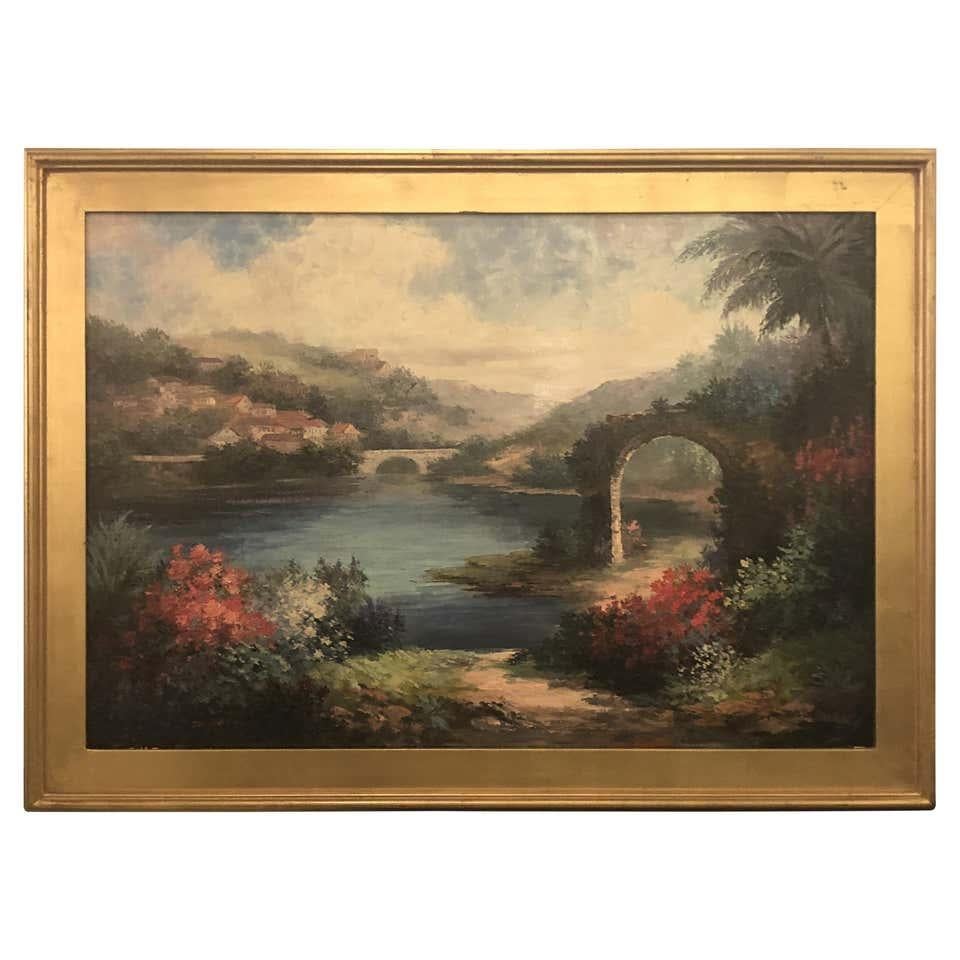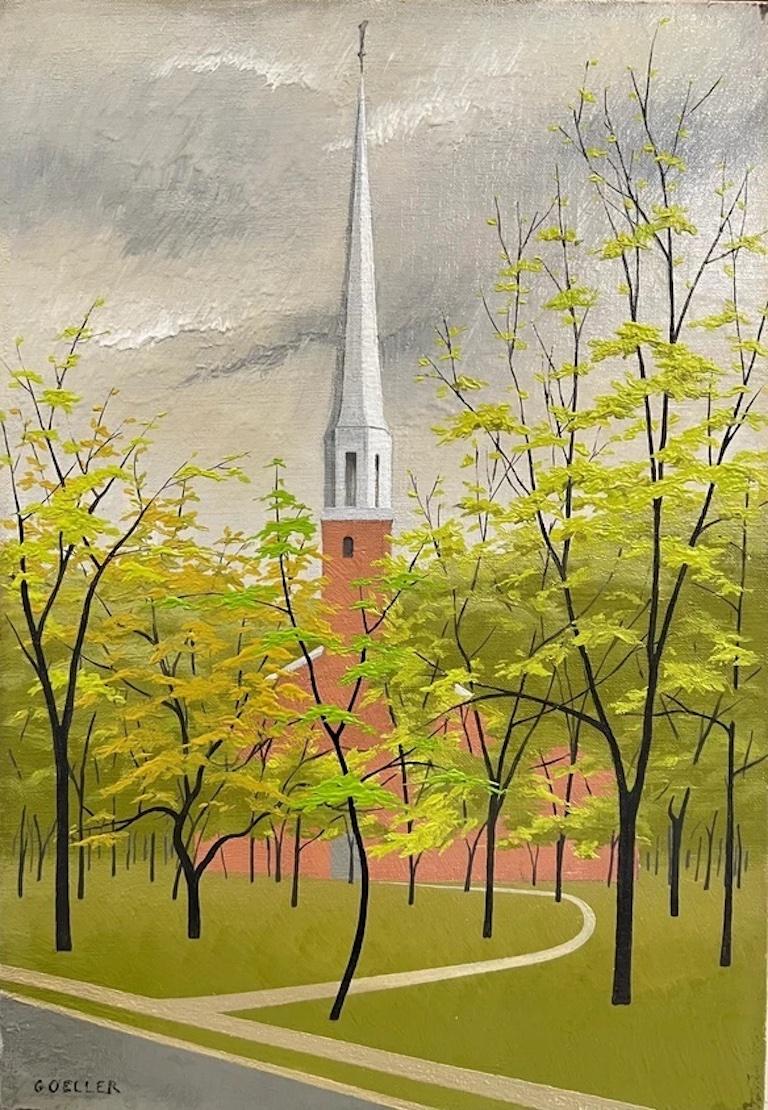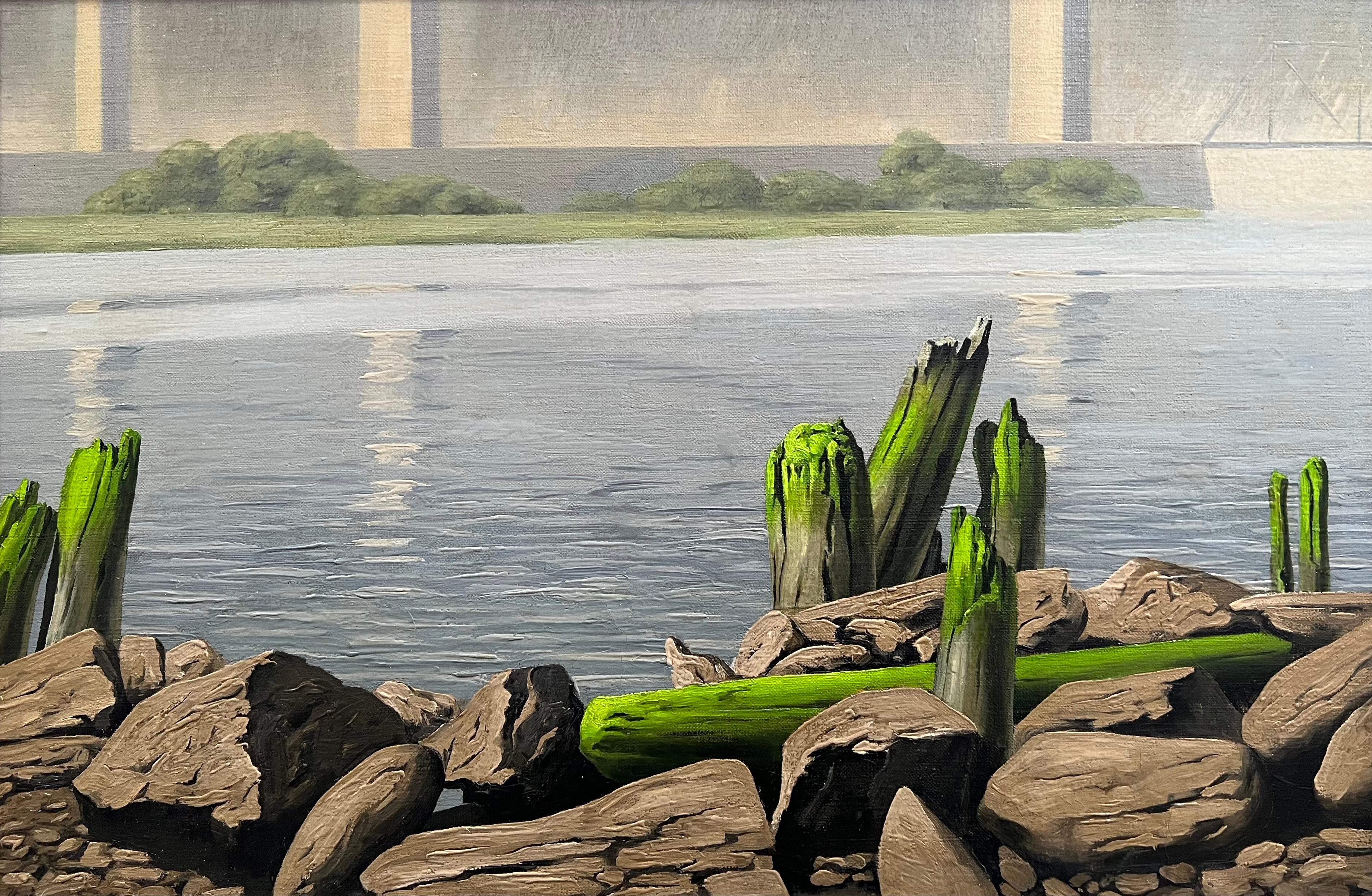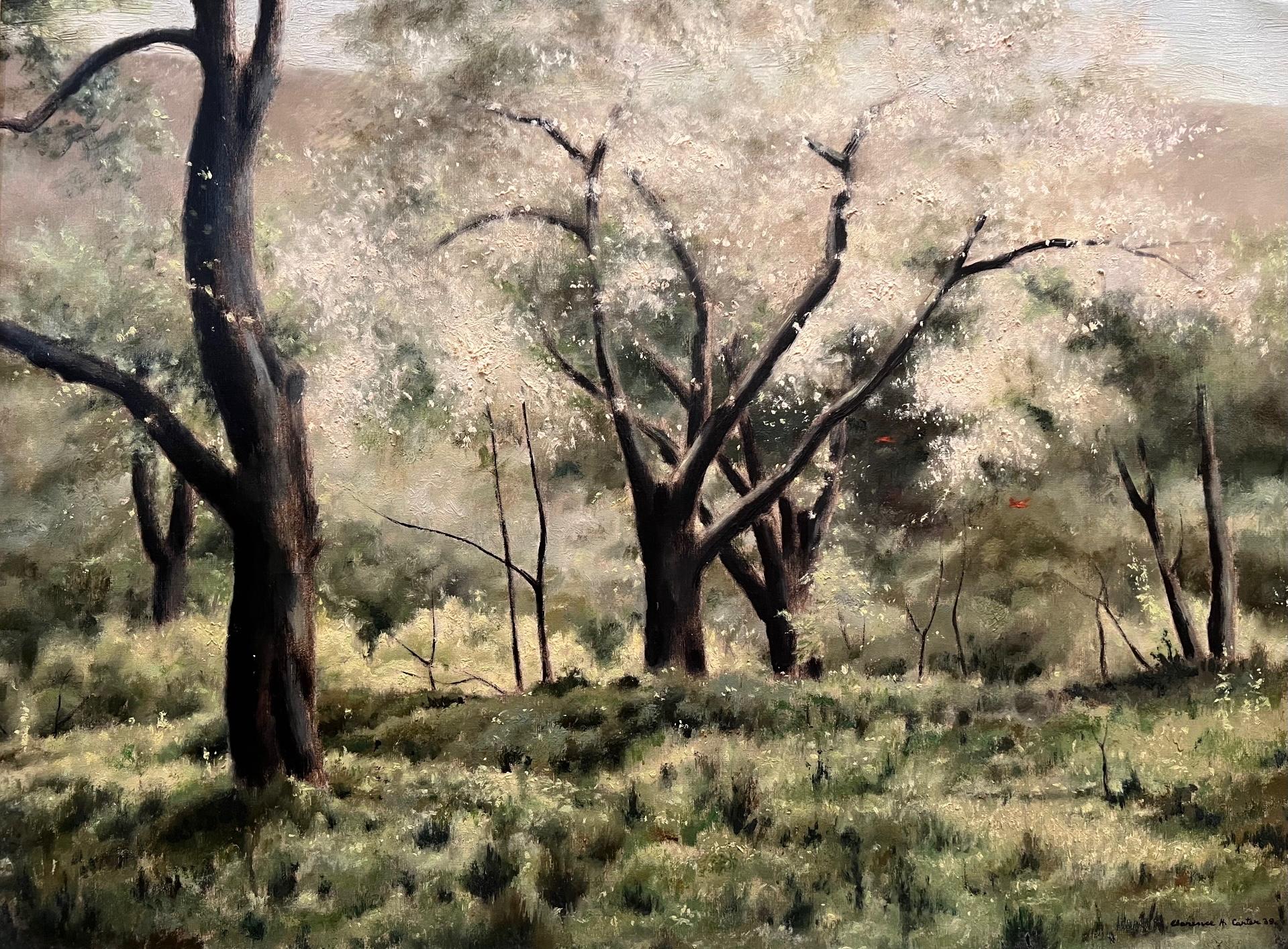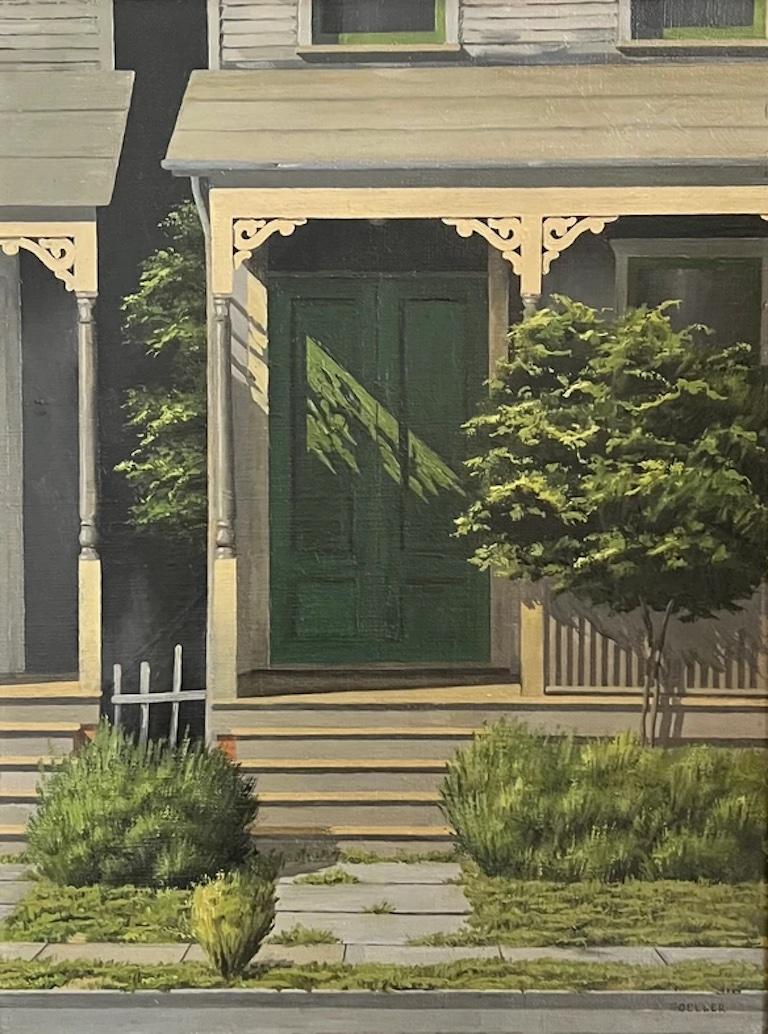Items Similar to Untitled (Country Landscape with Figures)
Want more images or videos?
Request additional images or videos from the seller
1 of 8
(William) Davenport GriffenUntitled (Country Landscape with Figures)1936
1936
About the Item
A Modernist landscape painting with figures by artist (William) Davenport Griffen. His paintings tend to be rare.
(William) Davenport Griffen was born in 1894 in Millbrook, NY. He graduated from Iowa State College in Ames, IA in 1918 with a B.S. in Civil Engineering; however, Griffen’s true love was painting. In 1919, he enrolled in the Chicago Academy of Fine Arts and subsequently studied at the Art Institute of Chicago from 1923-1928. In 1926, he was awarded the American Travel Scholarship and began painting in Provincetown, MA. In 1928, he was awarded the John Quincy Adams Scholarship and spent six months painting in Paris, France. Griffen also painted in the U.S. Virgin Islands for 11 months between 1930-1931. Griffen had one-man exhibitions of his Virgin Islands paintings at The Art Institute of Chicago and at Montross Galleries in New York, NY in 1931. Griffen exhibited at the Art Institute of Chicago 34 times between 1927 and 1943. He also exhibited at the Salon d’Automne in Paris, The Carnegie Institute in Pittsburgh, PA, The Pennsylvania Academy of Art, Philadelphia, PA, The Whitney Museum of American Art, New York, NY, The Corcoran Biennial, Washington, D.C., and the Century of Progress Exhibitions, Chicago, IL, 1933-1934. Griffen became an instructor of composition and life drawing at the Art Institute of Chicago from 1927-1930. He won numerous prizes for his work including the Augustus Peabody Prize from the Art Institute of Chicago in 1929 and The Logan Medal at the Art Institute of Chicago, 1930. Griffen completed two WPA post office murals, “The Good News and Bad”, Flora, IL, 1937 and “Service to the Farmer”, Carmi, IL, 1939. During WWII, Griffen once-again returned to his civil engineering background and served at the Naval air base in Glenview, IL and subsequently was employed by the U.S. Army Corps of Engineers in Joliet, IL where he met his wife, Loretta Simmons, in 1943. Griffen adopted her three children from her first marriage and they had a son together, Peter. After WWII, Griffen relocated to near San Francisco, CA where he continued to paint and exhibit, but also worked as a civil engineer. He died in Rohnert Park, CA in 1986. Griffen’s work is represented in the permanent collections of the Art Institute of Chicago, The Museum of Fine Arts, Boston and the Smithsonian American Art Museum, Washington, D.C. Griffen is one of the artists featured in the 1933 J.Z. Jacobson book, “Art of Today, Chicago”.
- Creator:(William) Davenport Griffen (1894 - 1986)
- Creation Year:1936
- Dimensions:Height: 15 in (38.1 cm)Width: 20 in (50.8 cm)
- More Editions & Sizes:Framed size: 22" x 24"Price: $3,500
- Medium:
- Movement & Style:
- Period:
- Condition:See Photos.
- Gallery Location:Chicago, IL
- Reference Number:1stDibs: LU2591212736072
About the Seller
No Reviews Yet
Vetted Seller
These experienced sellers undergo a comprehensive evaluation by our team of in-house experts.
Established in 2000
1stDibs seller since 2023
9 sales on 1stDibs
Typical response time: <1 hour
- ShippingRetrieving quote...Ships From: Chicago, IL
- Return PolicyThis item cannot be returned.
More From This SellerView All
- Untitled (Vineyard Harbor)By Francis ChapinLocated in Chicago, ILA colorful view of Martha's Vineyard by Francis Chapin, from the 1930s. Francis Chapin, affectionately called the “Dean of Chicago Painters” by his colleagues, was one of the city’s most popular and celebrated painters in his day. Born at the dawn of the 20th Century in Bristolville, Ohio, Chapin graduated from Washington & Jefferson College near Pittsburgh, Pennsylvania before enrolling at the Art Institute of Chicago in 1922. He would set down deep roots at the Art Institute of Chicago, exhibiting there over 31 times between 1926 and 1951. In 1927 Chapin won the prestigious Bryan Lathrop Fellowship from the Art Institute – a prize that funded the artist’s yearlong study trip to Europe. Upon his return to the United States, Chapin decided to remain in Chicago, noting the freedom Chicago artists have in developing independently of the pressure to conform to pre-existing molds (as was experienced by artists in New York, for example). Chapin became a popular instructor at the Art Institute, teaching there from 1929 to 1947 and at the Art Institute’s summer art school in Saugatuck, Michigan (now called Oxbow) between 1934 – 1938 (he was the director of the school from 1941-1945). A prolific painter, Chapin produced numerous works while traveling in Mexico, France, Spain, Saugatuck and Martha’s Vineyard, where he frequently spent summers and taught at the Old Sculpin Gallery there. Chapin was best recognized for his dynamic and vibrant images of Chicago during the 1930s and 40s. Chapin was a resident of the Old Town neighborhood where he lived and kept his studio on Menomonee Street for many years. Described as a “colorful figure, nearly 6 feet 6 inches tall, and thin, and usually wearing tweeds”, it is easy to imagine Chapin at work observing the busy street life of the city. In addition to his many exhibitions at the Art Institute of Chicago, Chapin’s work was shown during his lifetime at such institutions as the Pennsylvania Academy of Fine Arts, Philadelphia; the Corcoran Gallery, Washington, D.C.; the National Academy of Design, New York; the Museum of Modern Art, New York; the Whitney Museum of American Art, New York and the Carnegie Institute, Pittsburgh, among others. Francis Chapin’s paintings are represented in the collections the Art Institute of Chicago; the Friedman Collection, Chicago; the Butler Institute of American Art, Youngstown; the Denver Art Museum; the Everson Museum of Art, Syracuse; the Norton Museum of Art, West Palm Beach...Category
1930s American Modern Landscape Paintings
MaterialsMasonite, Oil
- Untitled (Martha’s Vineyard)By Francis ChapinLocated in Chicago, ILA colorful view of Martha's Vineyard (Depicting Edgartown's main street) by Francis Chapin, from around 1950. Francis Chapin, affectionately called the “Dean of Chicago Painters” by...Category
1950s American Modern Landscape Paintings
MaterialsMasonite, Oil
- Yellow Sky at MenemshaBy Francis ChapinLocated in Chicago, ILA colorful view of Menemsha in Martha's Vineyard by Francis Chapin, from around 1950. Francis Chapin, affectionately called the “Dean of Chicago Painters” by his colleagues, was one...Category
1950s American Modern Landscape Paintings
MaterialsMasonite, Oil
- Oak Bluffs, Mass. (Martha’s Vineyard)By Francis ChapinLocated in Chicago, ILA view of Oak Bluffs, MA on Martha's Vineyard by Francis Chapin, from around 1950. Francis Chapin, affectionately called the “Dean of Chicago Painters” by his colleagues, was one of...Category
1950s American Modern Landscape Paintings
MaterialsMasonite, Oil
- Western View from Sun Deck on Ajax Mt, Aspen, Colo.By Harold HaydonLocated in Chicago, ILA small, colorful Modernist landscape painting by Harold Haydon, depicting "Western View from Sun Deck on Ajax Mt., Aspen, Colo.", dated 1955. This pain...Category
1950s American Modern Landscape Paintings
MaterialsOil
- Vermont LandscapeBy Harold HaydonLocated in Chicago, ILA "Thumb Box" (Diminutive) painting of Vermont by Harold Haydon. Harold Emerson Haydon was born in Fort William, Ontario, Canada in 1909. Haydon came ...Category
1940s American Modern Landscape Paintings
MaterialsOil
You May Also Like
- Americana Landscape Oil on Canvas Painting Signed P. Paul, FramedLocated in Plainview, NYAn elegant oil on canvas landscape painting featuring a lake view in a paradisiac environment. The painting is finely framed in custom giltwood frame. A wonderful addition to any liv...Category
1980s American Modern Landscape Paintings
MaterialsOil, Canvas
- Six O'ClockLocated in Los Angeles, CASix O-Clock, c. 1942, oil on canvas, 30 x 20 inches, signed and titled several times verso of frame and stretcher (perhaps by another hand), marked “Rehn” several times on frame (for the Frank K. M. Rehn Galleries in New York City, who represented Craig at the time); Exhibited: 1) 18th Biennial Exhibition of Contemporary American Oil Paintings from March 21 to May 2, 1943 at The Corcoran Gallery of Art in Washington, D.C. #87, original price $450 (per catalog) (exhibition label verso), 2) Craig’s one-man show at the Frank K. M. Rehn Galleries, New York City, from October 26 to November 14, 1942, #10 (original price listed as $350); and 3) Exhibition of thirty paintings sponsored by the Harrisburg Art Association at the State Museum of Pennsylvania in Harrisburg in March, 1944 (concerning this exhibit, Penelope Redd of The Evening News (Harrisburg, Pennsylvania) wrote: “Other paintings that have overtones of superrealism inherent in the subjects include Tom Craig’s California nocturne, ‘Six O’Clock,’ two figures moving through the twilight . . . .” March 6, 1944, p. 13); another label verso from The Museum of Art of Toledo (Ohio): original frame: Provenance includes George Stern Gallery, Los Angeles, CA About the Painting Long before Chris Burden’s iconic installation outside of the Los Angeles County Museum of Art, Urban Light, another artist, Tom Craig, made Southern California streetlights the subject of one of his early 1940s paintings. Consisting of dozens of recycled streetlights from the 1920s and 1930s forming a classical colonnade at the museum’s entrance, Burden’s Urban Light has become a symbol of Los Angeles. For Burden, the streetlights represent what constitutes an advanced society, something “safe after dark and beautiful to behold.” It seems that Craig is playing on the same theme in Six O-Clock. Although we see two hunched figures trudging along the sidewalk at the end of a long day, the real stars of this painting are the streetlights which brighten the twilight and silhouette another iconic symbol of Los Angeles, the palm trees in the distance. Mountains in the background and the distant view of a suburban neighborhood join the streetlights and palm trees as classic subject matter for a California Scene painting, but Craig gives us a twist by depicting the scene not as a sun-drenched natural expanse. Rather, Craig uses thin layers of oil paint, mimicking the watercolor technique for which he is most famous, to show us the twinkling beauty of manmade light and the safety it affords. Although Southern California is a land of natural wonders, the interventions of humanity are already everywhere in Los Angeles and as one critic noted, the resulting painting has an air of “superrealism.” About the Artist Thomas Theodore Craig was a well-known fixture in the Southern California art scene. He was born in Upland California. Craig graduated with a degree in botany from Pomona College and studied painting at Pamona and the Chouinard Art School with Stanton MacDonald-Wright and Barse Miller among others. He became close friends with fellow artist Milford Zornes...Category
1940s American Modern Landscape Paintings
MaterialsCanvas, Oil
- Church in TreesLocated in Los Angeles, CAThis painting is part of our exhibition Charles Goeller: A Wistful Loneliness. Oil on canvas, 13 x 9 inches, Signed lower leftCategory
1940s American Modern Landscape Paintings
MaterialsOil, Canvas
- Arthur KillLocated in Los Angeles, CAThis painting is part of our exhibition Charles Goeller: A Wistful Loneliness. Oil on canvas, 15 ¾ x 24 inches, Signed and titled verso on stretcher Exhibited: [Solo Exhibition] Cha...Category
1940s American Modern Landscape Paintings
MaterialsCanvas, Oil
- Trees at BloomBy Clarence Holbrook CarterLocated in Los Angeles, CATrees at Bloom, 1939, oil on canvas, 32 x 24 inches, signed lower right About the Painting Trees at Bloom was painted when Clarence Holbrook Carter lived in Pittsburgh and served as an instructor in the Department of Painting and Design at the Carnegie Institute of Technology (now Carnegie-Mellon University), a position he held from 1938 through 1944. It depicts a thick forest at the base of distance hills just outside the city. During his tenure in Pittsburgh, Carter was deeply influenced by not only the industrial might of the steel mills and iron forges of the city, but also the beauty of the surrounding landscape. As Frank Anderson Trapp noted in his book on the artist, for Carter “the terrain itself had its own special vitality, with its craggy, wooded hills threaded with ravine and watercourses . . . . the signs of industrial blight that were unalleviated in some parts of the country were there relieved by the geological variety of the parent landscape, and by the irrepressible presence of its natural growth, which softened the whole.” Trapp continues, “in his scenes of rural situations, Carter had a special gift for rendering those elements convincingly.” With the profusion of flowering trees which diffuse the light and the red cardinals darting from one branch to another, Trees at Bloom portrays the “irrepressible presence of nature” that Trapp describes. About the Artist Together with Charles Burchfield, Clarence Holbrook Carter was Ohio’s premiere American Scene painter and later an innovative magic realist. The son of a no-nonsense public-school administrator, Carter was born in 1904 outside of Portsmouth, Ohio, a small town in the heart of the Ohio River...Category
1930s American Modern Landscape Paintings
MaterialsCanvas, Oil
- Across the StreetLocated in Los Angeles, CAThis painting is part of our exhibition Charles Goeller: A Wistful Loneliness. Oil on canvas, 16 x 12 inches, Signed lower right Exhibited: 1) [Solo E...Category
1940s American Modern Landscape Paintings
MaterialsCanvas, Oil
Recently Viewed
View AllMore Ways To Browse
Andrew Bailey
Victor Butko
Lebron Signed
Nikolay Dmitriev
Woodbury Ct
Liza Visagie
Agnes Reeve
Saguaro Art Framed
Train Layout
Carlos De Haes
Dawson Dawson Watson Paintings
Morning Joe
Sequoia Tree
Owen Jones Original
Vahe Yeremyan Meadow Painting
Vahe Yeremyan Meadow
Vintage Pacific Coast Highway Sign
Antique Grey Hounds
